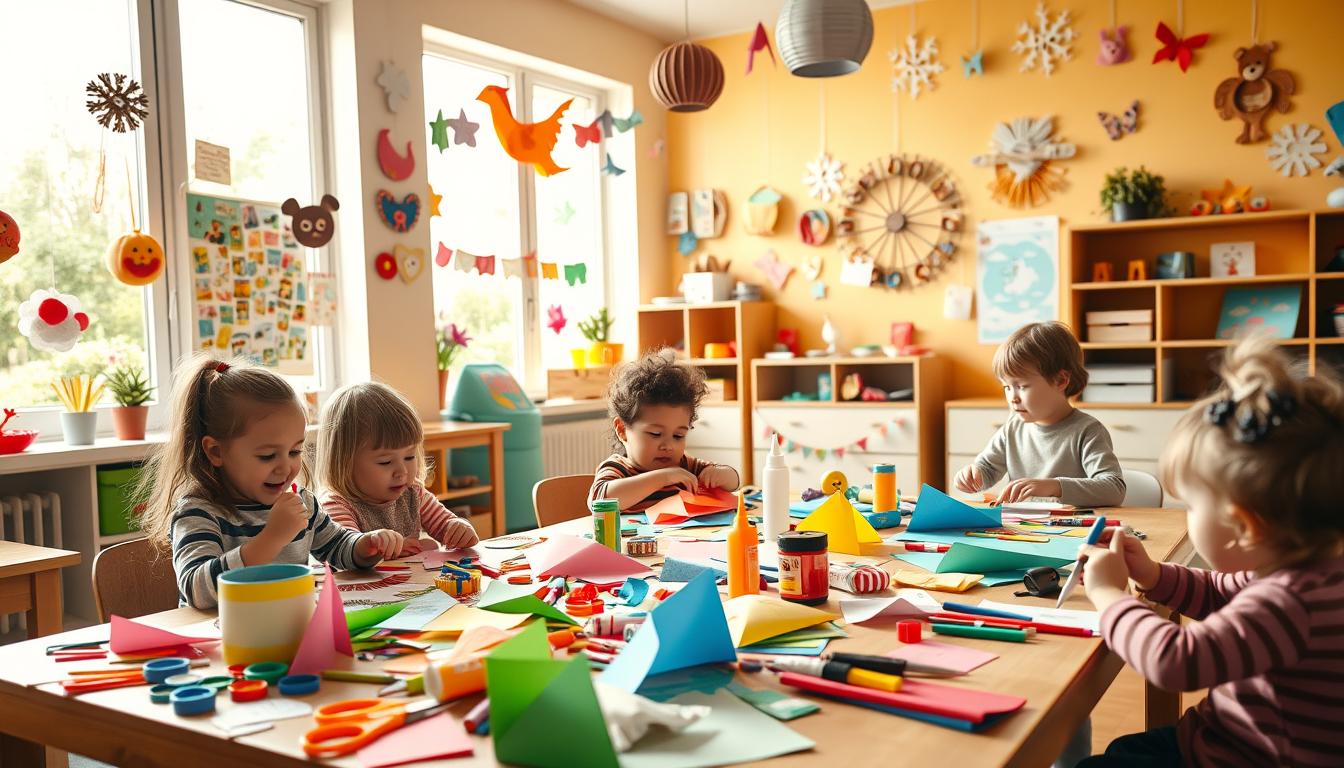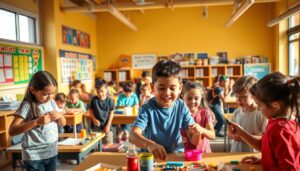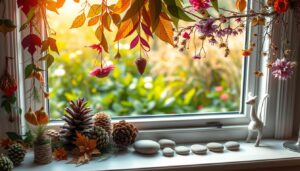Easy Paper Crafts for Preschoolers
“Play is the work of the child” – Maria Montessori’s timeless words capture the magic of hands-on learning. What better way to nurture young minds than with simple, joyful projects that spark creativity and growth?
These activities turn ordinary supplies like scissors and glue sticks into tools for discovery. Little ones strengthen fine motor skills while folding shapes or arranging colorful patterns. Every snip and sticker placement builds confidence, turning “I can’t” into “Look what I made!”
Best of all, you don’t need fancy materials. A stack of construction paper and washable markers can create hours of educational fun. Seasonal themes, animal cutouts, or collaborative murals adapt to any lesson plan or mood. The process matters more than perfection – messy glue and lopsided designs are part of the charm!
Key Takeaways
- Develops fine motor skills through cutting and folding
- Encourages creative problem-solving with open-ended projects
- Uses affordable, everyday materials found at home
- Adaptable for different skill levels and interests
- Supports early math and spatial reasoning concepts
- Fosters pride in independent creation
Discovering the Joy of Paper Crafts
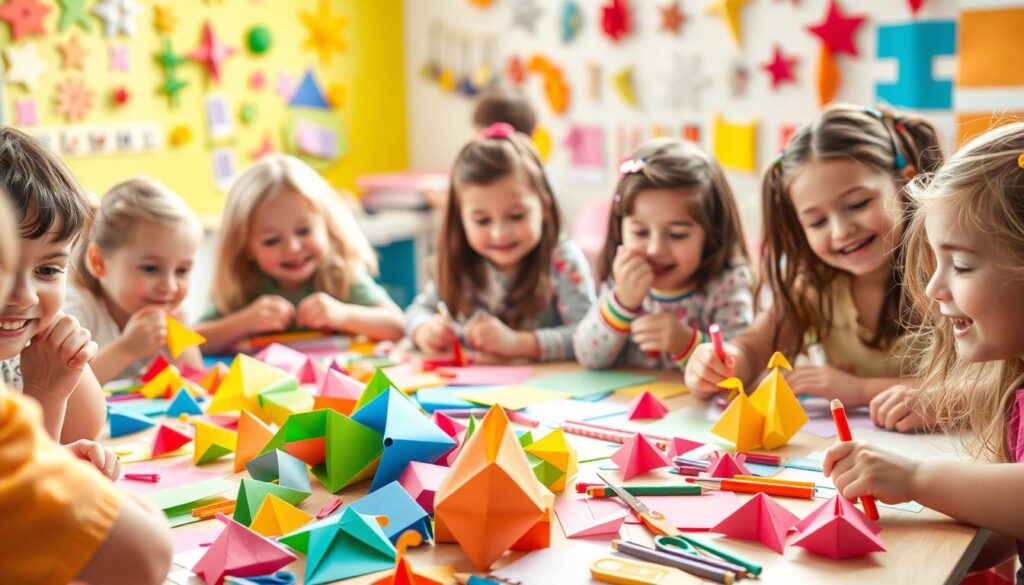
With just a few folds and cuts, children unlock a world where creativity meets learning. Therapists and educators alike praise these activities for helping little ones process emotions through hands-on creation. “A child’s artwork often speaks louder than words,” notes educator Leah Carter. Simple projects become safe spaces to explore feelings while building focus and coordination.
Different textures spark curiosity – crinkly tissue paper, glossy magazine pages, or sturdy cardboard each teach unique lessons. Little fingers learn control while tearing shapes or aligning edges. One preschool teacher shares: “My students beam with pride when their 3D animals ‘come alive’ during storytime.”
| Activity | Skill Boost | Stress Relief | Cleanup Time |
|---|---|---|---|
| Collage Making | Pattern Recognition | High | 2 Minutes |
| Finger Painting | Color Mixing | Medium | 15 Minutes |
| Paper Sculptures | Spatial Reasoning | High | 3 Minutes |
Group projects turn individual efforts into shared triumphs. When kids combine their paper flowers into a garden mural, they practice teamwork without realizing it. This art form’s magic lies in its simplicity – no spills or stains, just pure creative freedom.
Getting Started with Your Craft Projects
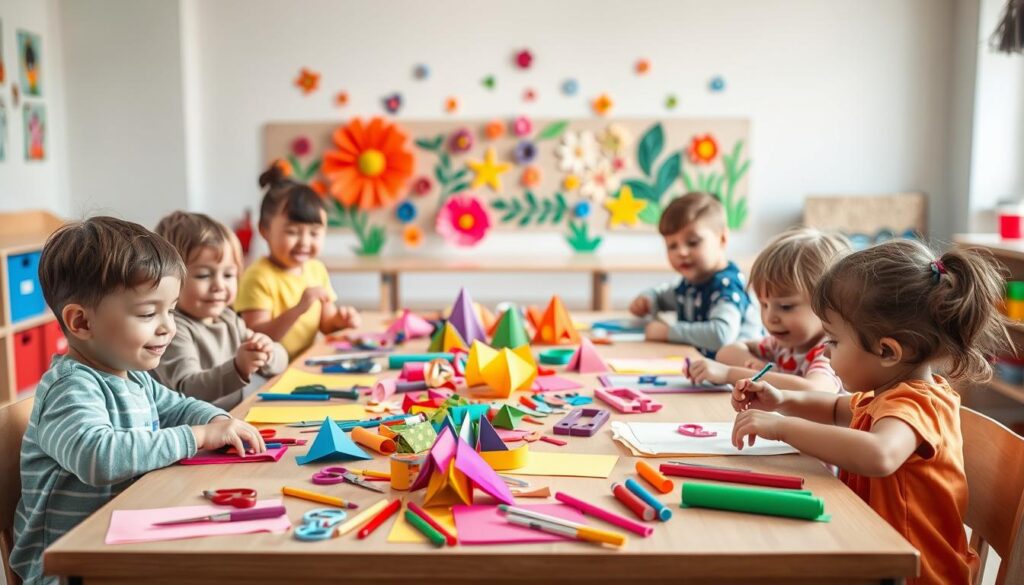
Young creators thrive when activities match their curiosity and capabilities. Choosing age-appropriate projects builds enthusiasm while teaching foundational skills through play. Let’s explore how these creative sessions support growth while keeping engagement high.
Benefits for Preschool Development
Handling scissors and glue sticks strengthens finger muscles needed for writing. Folding shapes improves spatial reasoning, while arranging patterns teaches basic math concepts. One teacher observes: “Students who craft regularly show better pencil grip and attention spans.”
Following step-by-step instructions boosts problem-solving abilities. When a folded frog doesn’t jump perfectly, kids learn to adjust their technique. This trial-and-error process builds resilience and creative thinking skills.
Fun and Simple Crafting Methods
Begin with tactile experiences like tearing colored sheets into mosaic pieces. Crumbling tissue paper into 3D flowers develops hand strength. Basic origami animals, like jumping frogs, introduce geometry through play.
Try these low-stress ideas:
- Sticker collages for color matching practice
- Paper chain garlands to explore patterns
- Texture rubbings using leaves under thin sheets
Projects evolve with skill levels. A child’s first lopsided snowflake becomes precise cutouts within weeks. Celebrate progress, not perfection – every creation marks developmental strides.
Essential Materials and Tools for Creative Crafts
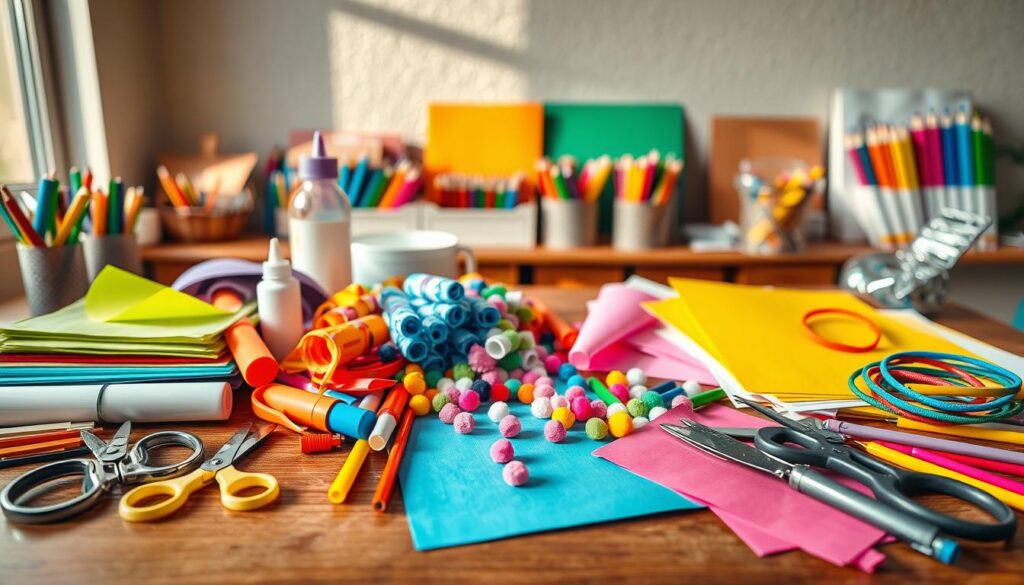
Gathering supplies for young artists doesn’t require complex shopping lists. Most items live in kitchen drawers or classroom cabinets already. The magic lies in choosing tools that fit small hands while sparking big ideas.
Basic Supplies: Paper, Glue, and Scissors
Safety scissors with spring-action handles help little fingers master cutting without frustration. Printer paper works better than thick construction sheets for early folding attempts. As Red Ted Art suggests: “Lightweight card stock holds shape for 3D creations while remaining easy to cut.”
Washable glue sticks beat runny liquid adhesives for mess-free bonding. Crayons and chubby markers let kids personalize projects without precision pressure. Store everything in labeled bins – seeing colorful materials inspires spontaneous creativity.
Where to Find Affordable Materials
Dollar stores stock vibrant colored paper packs and sticker sheets. Save cereal boxes for free card stock – painted panels become sturdy puppet theaters. Online bulk orders deliver 500-count glue sticks perfect for classroom use.
Repurpose household items creatively:
- Old magazines for collage textures
- Junk mail envelopes as pattern templates
- Fabric scraps glued to scrap paper for sensory art
Rotate materials weekly to maintain excitement. A $5 investment in metallic markers or googly eyes can refresh familiar projects. Remember – the best tools fit tiny hands and growing imaginations.
Step-by-Step Guides for Fun DIY Projects
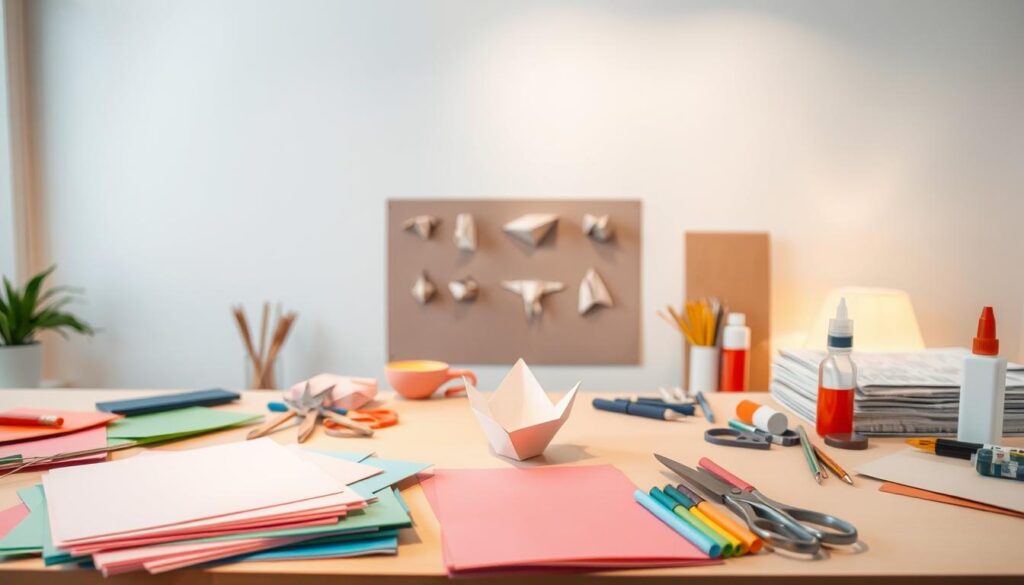
Transforming simple materials into playtime treasures starts with clear, kid-friendly instructions. Little hands thrive when each step feels achievable, turning confusion into proud giggles. Let’s explore how structured tutorials make creativity blossom while teaching real skills.
Finger Puppets and Paper Baskets
DIY paper puppets turn snack time into theater shows! Start with rectangular strips – markers add faces, while folded edges create finger holes. One teacher shares: “Puppet shows help shy students express stories they’d never share aloud.”
For baskets, use pre-cut templates to guide folding. Easter egg holders or desk organizers become projects kids use daily. Thicker sheets hold shape better, but even newspaper works for practice runs.
Simple Tutorials for Quick Creations
Short tutorials keep attention locked. Try 3-step bows from gift wrap scraps – fold, twist, and secure with glue dots. Printable dinosaur toys add science fun: color first, then assemble moving jaws.
Always include troubleshooting visuals. Photos showing “too much glue” versus “just right” help kids self-correct. As one parent notes: “My daughter beams when she fixes mistakes herself using the guide pictures.”
Remember – success lies in progress, not perfection. Crooked edges? Call them “silly snake baskets” and celebrate the effort!
Paper Crafts: Inspiring DIY Ideas for Young Minds
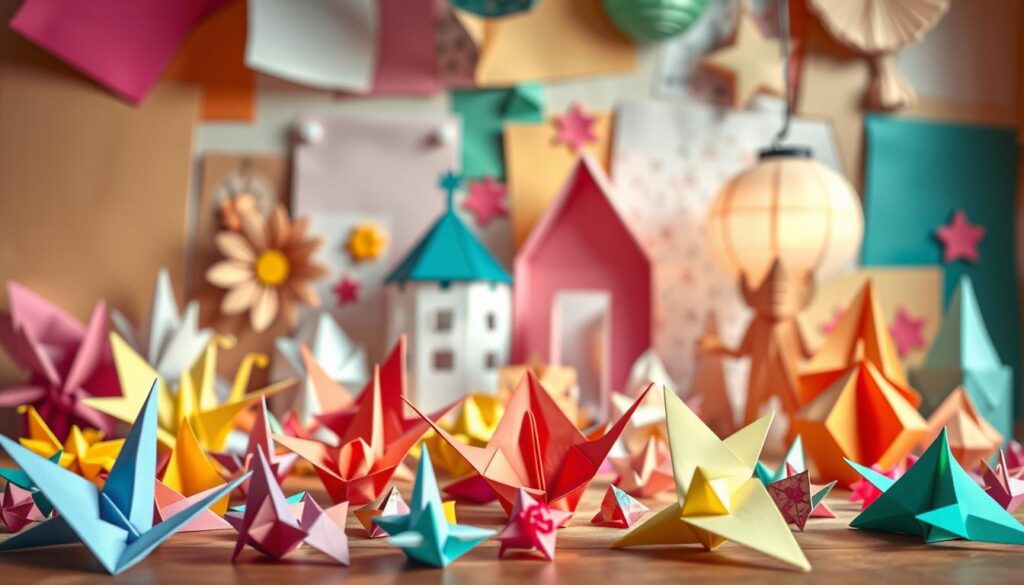
Little hands light up when transforming flat sheets into dimensional wonders. This creative journey builds skills while making keepsakes families treasure for years. Let’s explore projects that turn ordinary afternoons into memory-making adventures.
Creative Card and Ornament Projects
Personalized greeting cards let preschoolers share joy through art. Try accordion-fold rainbows – kids layer colored strips while learning pattern sequences. One parent shares: “My son’s wobbly birthday card became Grandma’s favorite gift!”
Seasonal paper ornaments adapt to any celebration. Winter snowflakes teach symmetry through folding, while spring blossoms introduce petal layering. These creations double as math lessons – counting points on stars or sorting shapes by color.
Easy Origami and Pop-Up Cards
Beginner origami projects like jumping frogs make geometry tangible. Start with pre-creased sheets to help small fingers master folds. Educator Mia Torres notes: “Watching paper transform into animals boosts spatial reasoning better than worksheets.”
Pop-up mechanisms create magical reveals in cards. Simple V-folds let dinosaurs “hatch” from eggs when pages open. These moving designs teach cause-effect relationships through play.
Corner bookmarks with animal faces encourage reading habits. Kids customize paper art with googly eyes while practicing precise cutting. The best projects grow with skills – today’s basic flower becomes tomorrow’s intricate bouquet.
Tips and Tricks for a Successful Craft Time
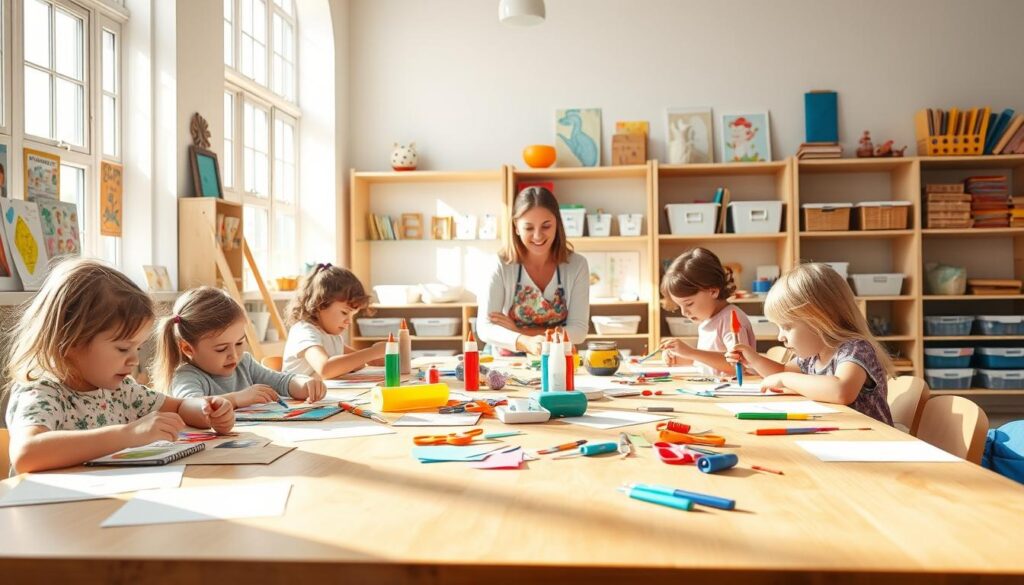
Preparation becomes the secret ingredient for joyful creating. A well-organized space lets kids dive into projects without interruptions, turning chaotic moments into focused fun. Start by designating a “maker zone” with washable surfaces and easy-to-reach materials.
Smart Systems for Smooth Sessions
Labeled bins with visual icons help preschoolers find glue sticks or markers independently. “When children know where things live, they spend more time creating than searching,” says art teacher Marco Silva. Use color-coded trays for multi-step projects to keep pieces sorted.
| Strategy | Benefit | Prep Time |
|---|---|---|
| Workspace Setup | Reduces distractions | 5 minutes |
| Flexible Timing | Respects individual pace | 0 minutes |
| Visual Guides | Supports independence | 2 minutes |
Build in extra minutes for cleanup rituals. Sing a silly song while wiping tables to make tidying feel like play. Photograph finished pieces before recycling them – these snapshots become growth records parents cherish.
Adapt tutorials by offering choices: “Would you like zigzag scissors or regular ones today?” This approach maintains structure while nurturing creative problem-solving. Celebrate unexpected designs – a lopsided hat might inspire new project ideas!
Conclusion
Tiny hands gain mighty abilities through joyful creation with everyday materials. These activities do more than entertain – they shape growing minds. Paper crafts build bridges between play and learning, turning crumpled sheets into confidence boosters.
Affordable projects let every family join the fun. A recycled box becomes a spaceship. Scrap paper transforms into math games. Kids beam when their “I made this!” moments get displayed on the fridge.
Early successes with simple tutorials make lifelong learners. Following steps teaches focus. Fixing mistakes builds grit. Shared creations strengthen bonds – grandparents and preschoolers giggle while gluing googly eyes onto leaf collages.
The magic lives beyond childhood. Skills from folding frogs or making cards prepare kids for science class and job interviews. Most importantly? These moments become cherished memories where love sticks better than glue.
FAQ
What basic supplies are needed for preschooler-friendly activities?
How can I keep my child engaged during creative sessions?
Where can I find budget-friendly materials?
Are there quick projects suitable for short attention spans?
How do crafting activities help developmental skills?
What are some safe alternatives to scissors for young kids?

Eduard Kingly is a travel and lifestyle content creator with a focus on personal development and education. He combines firsthand travel experiences with research-driven insights to guide readers in discovering new places, building better habits, and pursuing meaningful learning.

